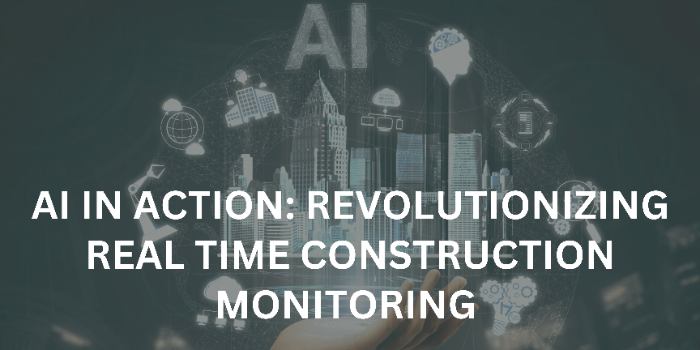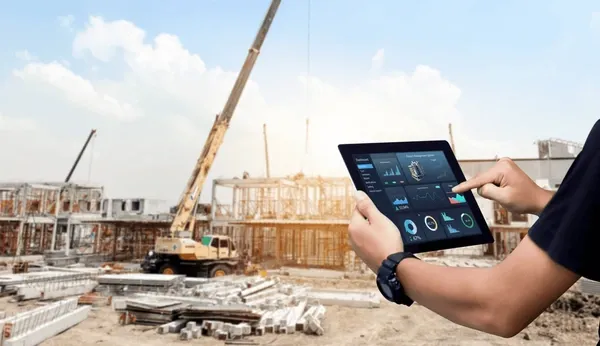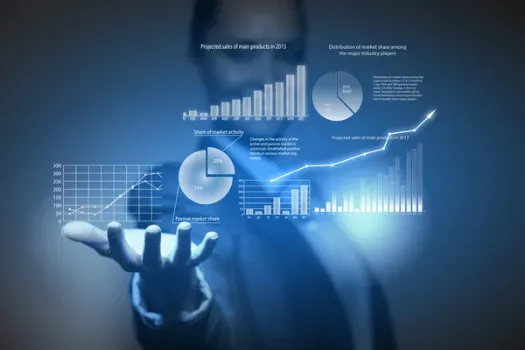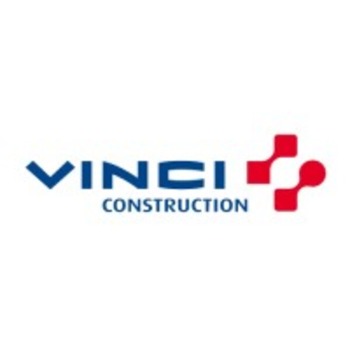
AI in Action: Revolutionizing Real-Time Construction Monitoring and Risk Management
The construction industry is experiencing a digital revolution, with Artificial Intelligence (AI) leading in transforming how projects are managed and executed. One of the most significant developments in recent years is the application of AI in real-time construction monitoring and risk management. By integrating AI, construction firms can monitor project progress in real time, anticipate potential risks, and make data-driven decisions that keep projects on schedule, within budget, and safer for all involved.
In this article, we will explore the impact of AI on construction monitoring and risk management, delve into the various AI-powered technologies that are reshaping the industry, and provide real-world examples of how AI is already making a difference in construction projects. The goal is to highlight how AI can drive efficiency, reduce risks, and ultimately lead to more successful project outcomes.
The Rise of AI in Construction: A Game-Changer for Project Monitoring
The construction industry has long been associated with the slow adoption of new technologies. However, this has changed dramatically in recent years, as companies recognize the potential of AI to revolutionize how they operate. AI's ability to analyze vast amounts of data in real time and make predictive decisions is a game-changer for an industry where time and budget constraints are critical.

AI in Real-Time Monitoring: A New Era of Project Oversight
One of the key benefits of AI in construction is its ability to provide real-time monitoring. In the past, construction managers relied on periodic site visits, manual reports, and delayed data to assess the progress of a project. These traditional methods often led to inefficiencies, delays, and increased costs. AI is changing this by offering real-time insights into every aspect of a construction project.
AI-powered tools can collect and analyze data from multiple sources, including sensors, drones, cameras, and even wearables worn by workers. This data is processed in real time and presented to project managers in an easily digestible format. With AI, managers can monitor the movement of materials, equipment, and personnel, ensuring that everything is progressing according to plan. If an issue arises, such as a delay in material delivery or a safety hazard, AI can immediately flag it, allowing for swift corrective action.
For example, if a piece of equipment is not where it should be, AI can detect this anomaly and notify the project manager, preventing potential delays. Similarly, AI can analyze the efficiency of various tasks, identifying areas where improvements can be made to optimize productivity.
The Power of Proactive Risk Management with AI
Risk management is an integral part of any construction project. Traditionally, managing risks involved relying on historical data and human intuition to anticipate potential issues. However, this approach has its limitations, as it is often reactive rather than proactive. AI is transforming risk management by enabling construction firms to predict potential risks before they become critical issues.
Predictive Analytics: Anticipating Problems Before They Happen

AI excels at predictive analytics, which is the process of using historical and real-time data to forecast future events. In construction, predictive analytics can be used to anticipate delays, cost overruns, equipment failures, and even safety incidents. By analyzing data from past projects and comparing it with real-time data from current projects, AI can identify patterns and trends that may indicate potential risks.
For example, AI can analyze weather data to predict how upcoming conditions might impact construction schedules. If a major storm is forecasted, AI can suggest adjustments to the work schedule to avoid weather-related delays. Similarly, AI can analyze supply chain data to predict material shortages and recommend alternative suppliers or materials to keep the project on track.
By proactively identifying risks, AI empowers construction managers to take preventive measures, reducing the likelihood of costly delays and improving overall project outcomes.
AI-Driven Decision-Making: Leveraging Data for Better Results
In construction, making the right decisions quickly can mean the difference between a successful project and one that goes off course. AI plays a crucial role in helping project managers make informed decisions based on data, rather than relying solely on experience or intuition.
Data-Driven Insights for Smarter Decision-Making
AI can process vast amounts of data in real time, providing project managers with actionable insights that can be used to make better decisions. These insights can range from optimizing work schedules to reallocating resources, adjusting budgets, and even recommending changes to project design.
One of the key advantages of AI is its ability to analyze complex data sets and present them in a clear, understandable format. For example, AI can use machine learning algorithms to analyze data from thousands of past projects and identify patterns that are likely to lead to success or failure. This information can be used to make data-driven decisions that improve project outcomes.
Automating Routine Tasks
In addition to providing insights, AI can also automate many routine tasks that would otherwise require manual intervention. For instance, AI can automatically schedule tasks based on real-time data, ensuring that the right resources are allocated to the right tasks at the right time. This level of automation not only improves efficiency but also reduces the potential for human error.
AI can also be used to automate the process of tracking project progress and reporting on key performance indicators (KPIs). By continuously monitoring data from the construction site, AI can generate real-time reports that provide project managers with a clear picture of how the project is progressing. This allows for faster decision-making and ensures that any issues are addressed promptly.
Enhancing Safety with AI: Preventing Accidents Before They Happen
Safety is a top priority in construction, and AI is playing an increasingly important role in improving safety on construction sites. AI-powered safety monitoring systems can analyze data from cameras, sensors, and wearables to detect potential hazards and unsafe behaviors in real time.
AI-Driven Safety Monitoring Systems
AI can monitor construction sites for unsafe conditions, such as workers not wearing proper safety gear or equipment being operated in unsafe ways. When AI detects a safety risk, it can immediately alert the project management team, allowing them to intervene and prevent accidents.

For example, AI can analyze video footage from cameras placed around the construction site to detect when workers are not following safety protocols. If a worker is not wearing a helmet or is operating machinery unsafely, the AI system can send an alert to the site supervisor, who can then take corrective action.
This proactive approach to safety not only reduces the risk of accidents but also helps create a safer working environment for everyone on the construction site.
Case Studies: Real-World Examples of AI in Construction Monitoring and Risk Management
The transformative power of AI in real-time construction monitoring and risk management is already evident in several high-profile projects. Here are a few examples of how construction companies are successfully leveraging AI technology to improve project outcomes.
Case Study 1: Turner Construction's AI-Powered Safety Monitoring
.jpg)
Turner Construction, a major player in the global construction industry, implemented an AI-driven safety monitoring system on one of its large commercial projects. The system used AI to analyze data from cameras and sensors placed throughout the construction site. These devices monitored worker activity, machinery, and potential hazards in real time.
When the AI identified unsafe behaviors, such as workers not wearing proper safety gear or machinery operating too close to pedestrian zones, it immediately alerted the project management team. As a result, Turner was able to intervene promptly, preventing accidents and improving overall site safety. This proactive approach led to a significant reduction in workplace injuries, enhanced productivity, and a smoother project workflow.
Case Study 2: Vinci Construction's AI-Enhanced Project Forecasting

Vinci Construction, a global leader in the construction sector, has integrated AI into its project forecasting and risk management processes. During the construction of a major transportation hub, Vinci utilized an AI system to predict potential delays and cost overruns. The AI analyzed data from multiple sources, including weather forecasts, supply chain information, and workforce productivity reports.
When the AI predicted that material deliveries might be delayed due to global supply chain disruptions, Vinci’s project managers took immediate action by sourcing alternative suppliers and adjusting schedules. This quick response prevented delays that could have derailed the project. By using AI to anticipate risks and make data-driven decisions, Vinci was able to complete the transportation hub on time and within budget.
Case Study 3: Balfour Beatty’s AI-Driven Progress Tracking
.jpg)
Balfour Beatty, a leading international infrastructure group, used AI to track the progress of a complex urban development project. The company deployed AI-powered drones and cameras to capture high-resolution images of the construction site. The AI system then analyzed these images to assess progress and compare it against project plans.
This real-time tracking enabled Balfour Beatty to identify areas where work was falling behind schedule and allocate resources more effectively. For example, when the AI detected delays in the installation of structural elements, the project management team quickly mobilized additional crews to get the work back on track. This level of visibility and responsiveness contributed to the project’s successful completion ahead of schedule.
The Future of AI in Construction Monitoring and Risk Management
AI is revolutionizing the construction industry by enabling real-time project monitoring, proactive risk management, and data-driven decision-making. As more construction companies adopt AI-powered solutions, the industry will continue to see improvements in efficiency, safety, and project outcomes.
The case studies highlighted in this article demonstrate the tangible benefits of AI in construction. From Skanska's real-time project monitoring to Mortenson's predictive risk management, AI is helping construction firms complete projects on time, within budget, and with fewer risks.
As AI technology continues to advance, the future of construction looks brighter than ever. With AI in action, construction projects will be safer, more efficient, and more successful than ever before.
By embracing AI, construction companies can stay ahead of the curve and ensure that they are well-positioned to meet the challenges of tomorrow's construction landscape.
Check https://app.bidlight.com for how BidLight can help you estimate your project!